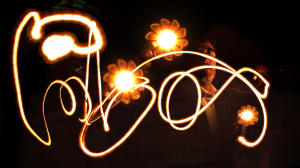Solar Power: Little Sun

Olafur. Eliasson, Din Blinde Passenger,2010
by Robert Moeller
The Council for the Arts at MIT announced last October that Olafur Eliasson had won the Eugene McDermott Award. The award includes a cash prize ($100,000.) and campus residency for the artist and a gala held in his honor. The Berlin-based Eliasson, mainly know for his large spectacular installations—notably The New York City Waterfalls and the weather project at the Tate Modern—is at heart a collaborator. Whether it is with scientists, engineers or architects, he seems most comfortable out in the world of ideas, picking someone’s brain while at the same time formulating a way to insert his artistic practice into the contemporary mix. The results are hard to codify as they veer out across so many disciplines and engage a host of issues. One is reminded of Leonardo’s wandering mind, visible in his notebooks, when considering Eliasson’s work.
Recently, in March, Eliasson was at MIT’s Sloan School discussing another of his projects. Called Little Sun, it is a small solar-powered lamp that he has begun selling in the developing world. The lamp, shaped like small sunflower, is worn around the neck on a strap and as he calls it is “a work of art that works in life.” It is designed to allow people who have limited access to a power grid have light in the evening. More specifically, it allows children to study at night without using kerosene lamps that emit a host of toxic materials into the air as they do their schoolwork: the toxins in the kerosene, according to some studies, equal the toxins in the smoke of some 40 cigarettes.
Little Sun, which was introduced at the Tate Modern in 2012, was designed by Eliasson along with engineer Frederik Ottesen, and interestingly is a business venture rather than part of any international aid or development package. Both men have traveled to Africa working to build relationships with retailers on a granular level, as well as test marketing the lamp with local people. The idea is to invest entire communities in the product’s use while keeping localized profits made from the selling of the device.
Olafur Eliasson creating light graffiti. Image courtesy of Studio Olafur Eliasson.
The endeavor, both humanitarian and entrepreneurial, fits nicely into Eliasson’s broader notions of art making and his communal approach to discovery. It even sits firmly astride his first-world spectacles in the sense that the ambitions of the project go toward lighting up huge swathes of the under-developed world at night, using renewable energy. This too, is managed, while bringing attention to subjects (climate change, renewables and clean energy usage) that are vitally important to all of us, even those who face the everyday challenges of gaining access to fresh water and food.
For those of us living fully on the grid, Eliasson believes that the transformative aspects of his lamp might help bring awareness (even utility) to ongoing conversations about our energy choices. Indeed, he believes that allowing children to use the product will promote their continuing interest in additional products that don’t degrade the environment.
This intersection of art and science, carefully wedded to a sustainable business plan that looks outside of traditional markets and seeks a broad consumer base, is uniquely optimistic and for that Eliasson deserves credit. The harder work, it seems, rests with those of us who need the product least and are addicted to old-fashioned energy (and energy policies) that are only contributing to the slow burn of the place we call home.
-Robert Moeller

